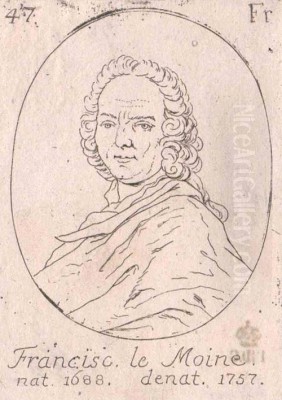
François Lemoyne stands as a pivotal figure in the transition from the grandeur of the late Baroque to the lighter, more sensuous aesthetic of the Rococo in early 18th-century France. Born in Paris in 1688, Lemoyne navigated the competitive world of the Royal Academy of Painting and Sculpture (Académie Royale de Peinture et de Sculpture) to become one of the most celebrated history painters of his generation, ultimately achieving the prestigious title of Premier peintre du Roi (First Painter to the King). His career, marked by significant triumphs, including the monumental ceiling of the Salon d'Hercule at Versailles, was tragically cut short by his suicide in 1737. Despite his relatively brief life, Lemoyne left an indelible mark on French art, influencing prominent successors and embodying the elegance and technical brilliance of his era.
Early Life and Artistic Formation
François Lemoyne entered the world in Paris, a city already established as the epicenter of European art and culture under the reign of Louis XIV. Little is documented about his earliest years or family background, but his artistic inclinations must have manifested early. By the age of 13, around 1701, he embarked on his formal artistic training, entering the studio of Louis Galloche. Galloche, a respected history painter and member of the Académie Royale, provided Lemoyne with a solid foundation in the principles of drawing, composition, and painting, adhering to the academic traditions established by predecessors like Charles Le Brun. Lemoyne remained under Galloche's tutelage for over a decade, until 1713, absorbing the prevailing taste for large-scale historical and mythological subjects executed in the Grand Manner.
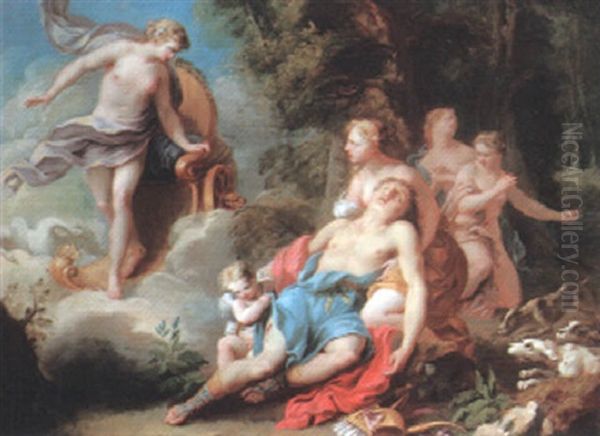
His talent was evident, and he pursued the ultimate prize for aspiring French artists: the Prix de Rome. This prestigious award, granted by the Académie Royale, offered the winner a funded period of study in Rome, allowing direct exposure to the masterpieces of antiquity and the Italian Renaissance and Baroque. Lemoyne competed for the prize, finally achieving victory in 1711 with his painting Ruth and Boaz. However, due to the financial strains on the French crown caused by the War of the Spanish Succession, the funds for the Rome scholarship were often delayed or unavailable. Consequently, Lemoyne had to postpone his Italian journey.
Despite this initial setback, Lemoyne continued to hone his skills and build his reputation within the Parisian art scene. He was accepted (agréé) into the Académie Royale in 1716, a crucial step towards full membership. His reception piece for full membership as an Academician, presented in 1718, was Hercules Slaying Cacus. This work demonstrated his mastery of anatomical drawing, dynamic composition, and the dramatic rendering of mythological narratives, firmly establishing him within the academic hierarchy. He also studied briefly with Pierre-Jacques Cazes, another notable academic painter, further refining his technique.
The Italian Sojourn and Its Influence
Although delayed, the opportunity for Lemoyne to travel to Italy eventually materialized. He undertook the journey around 1723-1724, spending significant time absorbing the artistic riches of cities like Rome, Bologna, and Venice. This period proved profoundly influential, exposing him to a broader range of stylistic possibilities beyond the French academic tradition heavily influenced by Charles Le Brun and Nicolas Poussin.
In Rome, he studied the works of High Renaissance masters like Raphael and Michelangelo, as well as the leading figures of the Baroque, including Annibale Carracci, Guido Reni, and Pietro da Cortona. The powerful compositions, dramatic lighting, and emotional intensity of the Italian Baroque left a lasting impression. However, it was perhaps the art of Venice that resonated most deeply with Lemoyne's evolving sensibilities.
The Venetian school, particularly the works of Titian, Tintoretto, and especially Paolo Veronese, captivated him with their rich, luminous color palettes, dynamic compositions, and sensuous handling of paint. The sheer decorative splendor and theatricality of Veronese's large-scale narrative scenes offered a compelling alternative to the more austere classicism often favored in Paris. He was also drawn to the softer modeling and graceful figures found in the work of Correggio in Parma. This exposure to the Venetian colorito (emphasis on color) would significantly impact Lemoyne's own style, leading him towards lighter tones, more fluid brushwork, and a greater emphasis on visual pleasure. He also encountered the works of contemporary Italian painters, further broadening his artistic horizons.
Ascent in the Academic World
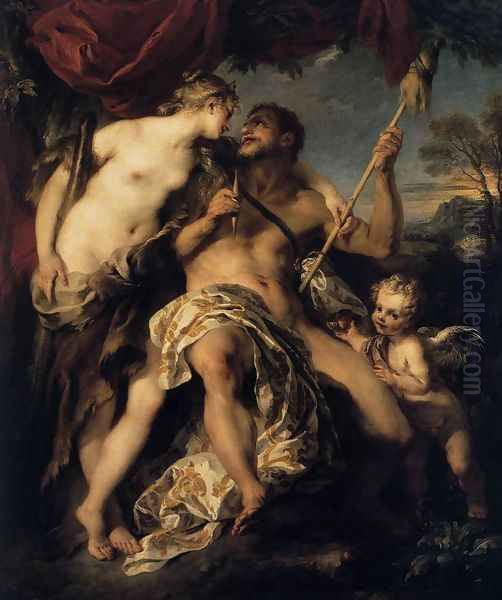
Upon his return to Paris around 1725, Lemoyne brought back not just sketches and studies, but a transformed artistic vision. He quickly reintegrated into the Parisian art world, his reputation enhanced by his Italian experience. He began receiving increasingly important commissions, both for easel paintings and decorative schemes. His style, now infused with Italianate warmth and color, began to distinguish him from many of his contemporaries.
He became a regular participant in the Salon, the official art exhibition of the Académie Royale, held periodically in the Louvre. These exhibitions were crucial for artists to display their talents, attract patrons, and engage in critical discourse. Lemoyne's submissions often garnered significant attention. In the Salon of 1725, he exhibited several works, including The Continence of Scipio, which was praised for its composition and noble sentiment, showcasing his ability to handle complex historical narratives with clarity and grace.
His academic career also progressed steadily. Following his full admission in 1718, he rose through the ranks, eventually being appointed Professor at the Académie Royale in 1733. This position not only recognized his artistic stature but also gave him a platform to influence the next generation of artists, teaching drawing from the live model and lecturing on art theory. His teaching emphasized the importance of solid draftsmanship combined with an appealing use of color and light.
The Grand Manner Meets Rococo: Lemoyne's Style
François Lemoyne's artistic style occupies a fascinating transitional space between the formal grandeur of the Louis XIV era, epitomized by Charles Le Brun, and the emerging Rococo aesthetic favored during the Régence and the reign of Louis XV. He retained the large scale and elevated subject matter (history, mythology, allegory) associated with the Grand Manner, but infused it with a new lightness, elegance, and sensuous appeal characteristic of the Rococo.
His compositions, while often complex and multi-figured, tend to be more dynamic and fluid than those of his Baroque predecessors. Diagonal lines, swirling movements, and asymmetrical arrangements create a sense of energy and grace. Figures are typically elegant and idealized, rendered with smooth modeling and delicate features. While capable of depicting powerful male figures like Hercules, Lemoyne excelled in portraying graceful female nudes and charming mythological scenes, often imbued with a subtle eroticism.
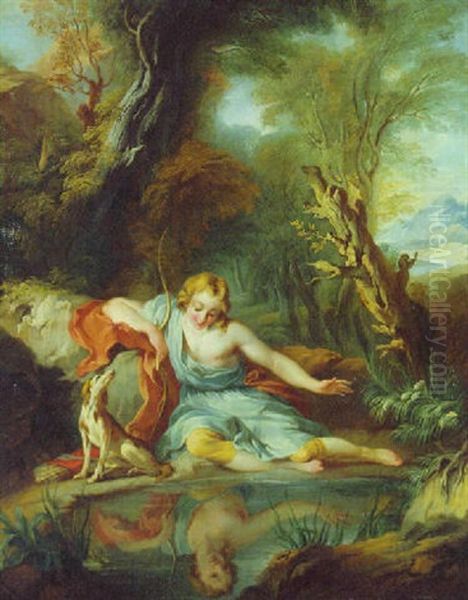
Perhaps the most significant development in Lemoyne's style, particularly after his Italian trip, was his use of color and light. He moved away from the darker, more somber palettes of the late Baroque towards brighter, clearer, and more luminous hues. Pinks, pale blues, yellows, and silvery grays dominate his canvases, applied with increasingly fluid and visible brushwork. He masterfully employed light to highlight key figures, create atmosphere, and enhance the overall decorative effect. This emphasis on color and light aligns him closely with the Rococo sensibility championed by artists like Antoine Watteau, though Lemoyne generally worked on a larger, more monumental scale. His approach contrasted with the more linear and sculptural style of contemporaries like Jean Restout.
Masterpieces and Major Commissions
Lemoyne's oeuvre includes numerous significant works that showcase his stylistic evolution and technical prowess. Early works like Ruth and Boaz (1711) and Hercules Slaying Cacus (1718) demonstrate his solid academic training. Following his return from Italy, his style blossomed in works like The Continence of Scipio (1725) and Venus and Adonis (c. 1729, Nationalmuseum, Stockholm), the latter notable for its delicate sensuality and luminous color.
He frequently depicted mythological lovers and heroines, subjects popular within the Rococo taste for charm and elegance. Works like Hercules and Omphale (1724, Louvre, Paris) exemplify this, showing the muscular hero captivated by the Lydian queen in a composition that balances classical strength with Rococo intimacy and playful eroticism. The rich textures of fabrics and the soft rendering of flesh are characteristic of his mature style. Another notable work is Narcissus (c. 1728), which captures the mythological youth entranced by his own reflection, treated with characteristic grace and a focus on idealized beauty.
Lemoyne also undertook significant decorative commissions. He contributed to the decoration of the Church of Saint-Sulpice in Paris and worked for private patrons. However, his most ambitious and ultimately career-defining project was the ceiling decoration for the Salon d'Hercule (Hercules Room) at the Palace of Versailles.
The Salon d'Hercule: A Monumental Achievement
Commissioned in 1729 by the Superintendent of the King's Buildings, the Duc d'Antin, the decoration of the ceiling of the Salon d'Hercule was one of the most prestigious projects awarded during the reign of Louis XV. The vast space, intended for grand receptions and balls, required a suitably impressive artistic statement. Lemoyne was chosen over his main rival, Jean-François de Troy, for this monumental task.
The subject chosen was The Apotheosis of Hercules, depicting the moment the mythological hero is welcomed into the assembly of the gods on Mount Olympus after completing his labors. Lemoyne worked tirelessly on this massive undertaking for several years, from 1733 to 1736. The final composition is a breathtaking display of artistic virtuosity, featuring over 140 figures swirling across the vast expanse of the ceiling in a complex, dynamic arrangement.
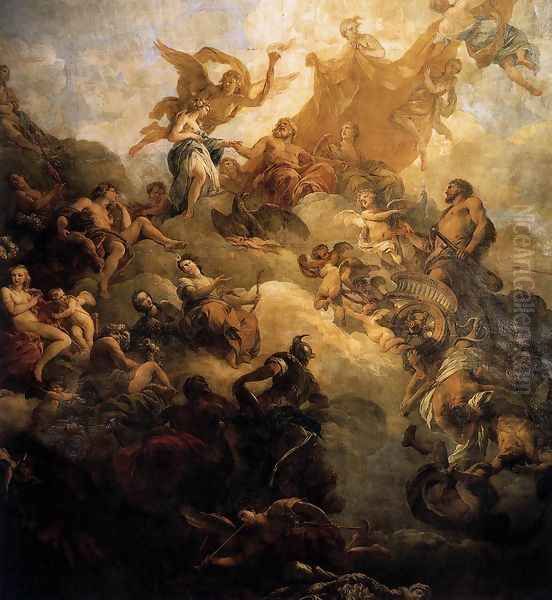
Drawing inspiration from Italian ceiling painters like Pietro da Cortona and Andrea Pozzo, Lemoyne created a vibrant celestial scene filled with gods, goddesses, allegorical figures, and putti, all rendered in his characteristic light, airy palette. Jupiter, Juno, Venus, Mars, and other deities welcome Hercules, who ascends towards immortality. The illusionistic perspective and the sense of boundless space are masterfully handled. The work seamlessly blends the grandeur required for a royal palace with the elegance and charm of the Rococo.
Upon its unveiling in 1736, the ceiling was met with widespread acclaim. It was hailed as a masterpiece, rivaling the great Italian frescoes and surpassing the achievements of French predecessors like Charles Le Brun in the nearby Hall of Mirrors. The success of the Salon d'Hercule cemented Lemoyne's reputation as the leading history painter in France and directly led to his appointment as Premier peintre du Roi later that same year. It remains one of the undisputed highlights of Versailles and a testament to Lemoyne's ambition and skill.
Teacher and Mentor: Shaping the Next Generation
Beyond his own artistic production, Lemoyne played a crucial role as an educator. As a professor at the Académie Royale, he influenced numerous students. His most famous pupils were François Boucher (1703-1770) and Charles-Joseph Natoire (1700-1777), both of whom would become leading figures of the mature Rococo style.
François Boucher, who briefly studied with Lemoyne around 1720, absorbed his master's emphasis on elegant drawing, sensuous subject matter, and a light, decorative color palette. Although Boucher developed his own distinct style, characterized by an even greater emphasis on charm, artifice, and pastoral themes, the foundations laid during his time with Lemoyne were significant. Boucher would go on to enjoy enormous success, eventually succeeding Lemoyne's position as Premier peintre du Roi decades later and becoming synonymous with the height of French Rococo painting, influencing artists like Jean-Honoré Fragonard.
Charles-Joseph Natoire also benefited greatly from Lemoyne's instruction. Natoire won the Prix de Rome in 1721 while working in Lemoyne's studio. He developed a successful career as a history painter and decorator, known for his graceful compositions and pleasing color schemes, clearly indebted to Lemoyne's example. Natoire undertook major decorative projects, such as the Oval Salon at the Hôtel de Soubise in Paris, and later became the Director of the French Academy in Rome. The success of both Boucher and Natoire demonstrates Lemoyne's effectiveness as a teacher and his importance in transmitting the Rococo aesthetic.
Rivalries and Recognition
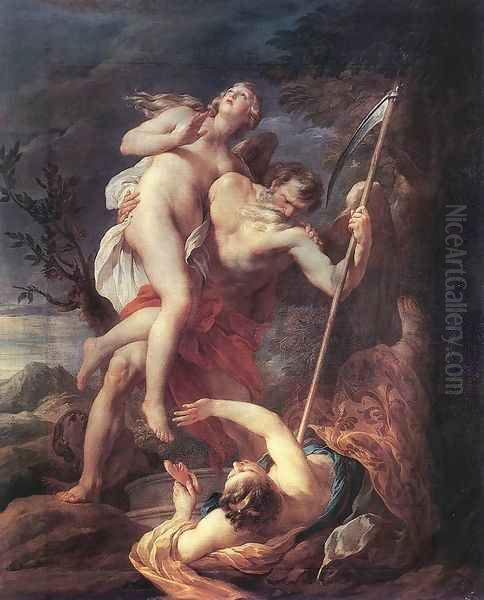
The Parisian art world of the early 18th century was highly competitive. Lemoyne's primary rival was Jean-François de Troy (1679-1752). Both artists vied for prestigious commissions and academic honors. De Troy, also a highly skilled history painter, possessed a style that, while also influenced by Italian art (particularly Venetian), often displayed a more robust and sometimes more overtly sensual character than Lemoyne's refined elegance. Their rivalry likely spurred both artists to greater heights, contributing to the vibrancy of the period. The competition for the Salon d'Hercule commission was a notable instance of their rivalry, with Lemoyne ultimately prevailing.
Lemoyne also worked alongside other significant artists of the time. Noël-Nicolas Coypel (1690-1734) was another respected history painter with whom Lemoyne sometimes competed or collaborated on projects. He was also a contemporary of artists like the portraitist Hyacinthe Rigaud, the still-life and animal painter Jean-Baptiste Oudry, and the pioneer of Rococo genre painting, Antoine Watteau, although Watteau's focus on fêtes galantes set him apart from Lemoyne's concentration on history painting.
Despite the rivalries, Lemoyne's talent was widely recognized. His steady ascent through the ranks of the Académie culminated in the highest possible honor for a French artist: his appointment as Premier peintre du Roi in 1736, following the death of Louis de Boullogne. This position placed him at the head of the royal artistic establishment, overseeing royal commissions and wielding considerable influence. It was the pinnacle of a successful, albeit demanding, career.
The Weight of Success: Personal Struggles and Tragic End
The immense effort required for the Salon d'Hercule ceiling, coupled with the pressures of his new position as First Painter to the King and the constant demands of patrons and the court, took a heavy toll on Lemoyne. Contemporary accounts suggest he suffered from increasing anxiety and depression. The loss of his wife added to his personal burdens, and he may have felt overwhelmed by the intrigues and expectations inherent in court life.
His mental state deteriorated rapidly after the completion of the Versailles ceiling. In June 1737, just months after receiving the ultimate royal appointment and shortly after finishing another major allegorical painting, Time Saving Truth from Falsehood and Envy (Wallace Collection, London), François Lemoyne tragically took his own life. On June 4th, 1737, he died in his Paris lodgings after stabbing himself multiple times with his sword. A contemporary police report detailed the grim discovery, noting nine wounds from the épée found beside him.
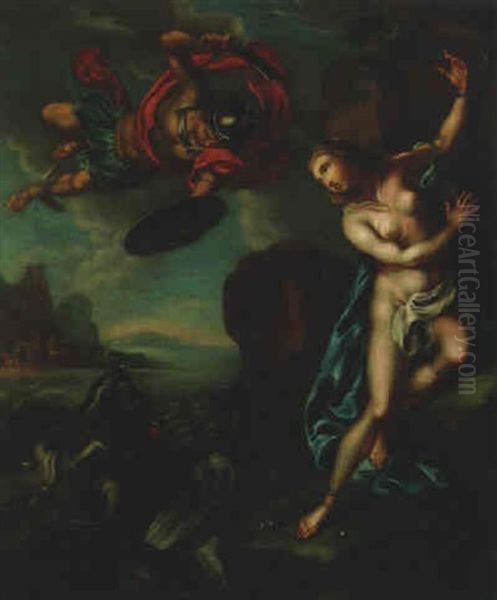
His suicide shocked the Parisian art world. It cast a shadow over his recent triumphs and highlighted the immense psychological pressures faced by artists navigating the complex social and professional landscape of the Ancien Régime. His death at the age of 49 cut short a brilliant career at its zenith.
Legacy and Influence
Despite his tragic end, François Lemoyne's legacy was significant and enduring. He played a crucial role in steering French painting from the formal classicism of the late 17th century towards the lighter, more decorative Rococo style that would dominate the reign of Louis XV. He successfully adapted the Grand Manner of history painting to the new aesthetic, creating works that were both monumental and elegant.
His influence was most directly felt through his students, François Boucher and Charles-Joseph Natoire. They carried forward his emphasis on graceful figures, luminous color, and mythological or allegorical themes, becoming leading exponents of the Rococo style. Through them, Lemoyne's influence extended to subsequent generations, including artists like Carle van Loo and Jean-Honoré Fragonard.
Lemoyne's Apotheosis of Hercules remains a landmark achievement in French decorative painting, a testament to his ability to synthesize Italian Baroque grandeur with French Rococo elegance on a monumental scale. His easel paintings, admired for their technical refinement and delicate sensibility, are held in major museums worldwide. He is remembered as a master of color and light, an artist who captured the grace and charm of his era while upholding the traditions of history painting. Though his life ended in tragedy, his art continues to be celebrated for its beauty, skill, and pivotal role in the evolution of 18th-century French art. He stands alongside Watteau, Boucher, and Fragonard as one of the defining painters of the French Rococo.